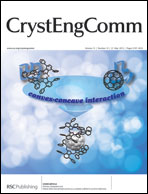The reaction of CuSCN (or CuCl2) in the presence of excess KSCN directed by viologen-based linear templates in a dimethyl formamide–methanol system affords six coordination polymers, {(MV)[Cu2(SCN)4]}n (1, MV2+ = 1,1′-dimethyl-4,4′-bipyridinium), {(PrV)[Cu2(SCN)4]}n (2, PrV2+ = 1,1′-dipropyl-4,4′-bipyridinium), {(iPV)[Cu2(SCN)4]}n (3, iPV2+ = 1,1′-diisopropyl-4,4′-bipyridinium), [(1-iBV)Cu2(SCN)3]n (4, 1-iBV2+ = 1-isobutyl-4,4′-bipyridinium), {(iBV)[Cu2(SCN)4]}n (5, iBV2+ = 1,1′-diisobutyl-4,4′-bipyridinium), and {(PtV)[Cu2(SCN)4]}n (6, PtV2+ = 1,1′-dipentyl-4,4′-bipyridinium). The [Cu2(SCN)4]n anion in compounds 1, 3 and 5 adopts an infinite two-dimensional polypseudorotaxane architecture and proved effectively that the stoppers at the end can enhance the polyrotaxane formation in the crystalline state, whereas the anion moieties in compounds 2 and 6 exhibit one-dimensional linear architectures, suggesting dethreading from envelopes once solidifying from solution phase. Compound 4 was found to be a two-dimensional coordination polymer with the organic ligand carrying a single charge. The side chain template effect of substituted group, UV-Vis diffuse reflectance spectra in the solid state and TGA properties of the six complexes are investigated.


 Please wait while we load your content...
Please wait while we load your content...